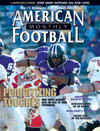AMERICAN FOOTBALL MONTHLY THE #1 RESOURCE FOR FOOTBALL COACHES
Article CategoriesAFM Magazine
|
Inside Zone Read: Three Ways to Combat the Games Defenses Playby: Eric DriskellOffensive Line Coach, Blue Valley HS (KS) © More from this issue Our base running play is the inside zone read out of the shotgun. We don’t block the backside end and since we are in the shotgun he becomes our read. Our offensive staff has had the opportunity to ask a lot of defensive coordinators at various levels ‘how do you defend zone read?’ Most of them answer that they have one defender on the backside responsible for chasing the running back and another to stay at home and ‘rob’ the QB. This can be done out of many different fronts. Defenses have now evolved to changing the personnel that are assigned to the above mentioned responsibilities. The games that defenses play with these two players can cause the offense problems and make it a difficult read. Three ways to combat the games that defenses play: 1. From Offset to Pistol: Moving the....The full article can only be seen by subscribers. Subscribe today!
|
|
|||||||
| HOME |
MAGAZINE |
SUBSCRIBE | ONLINE COLUMNISTS | COACHING VIDEOS |
Copyright 2025, AmericanFootballMonthly.com
All Rights Reserved





